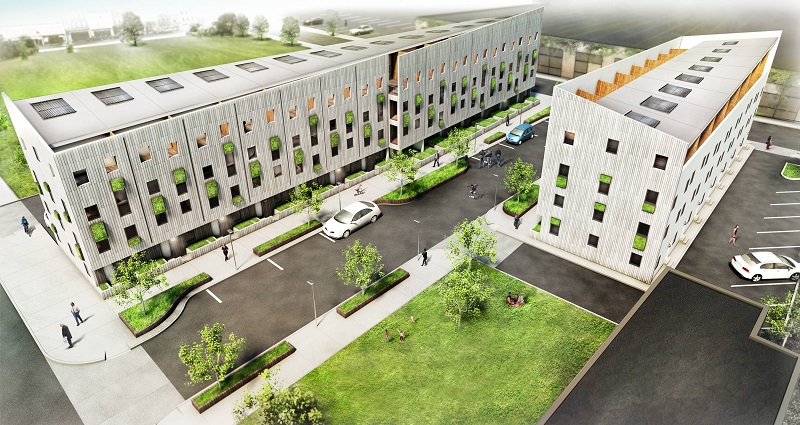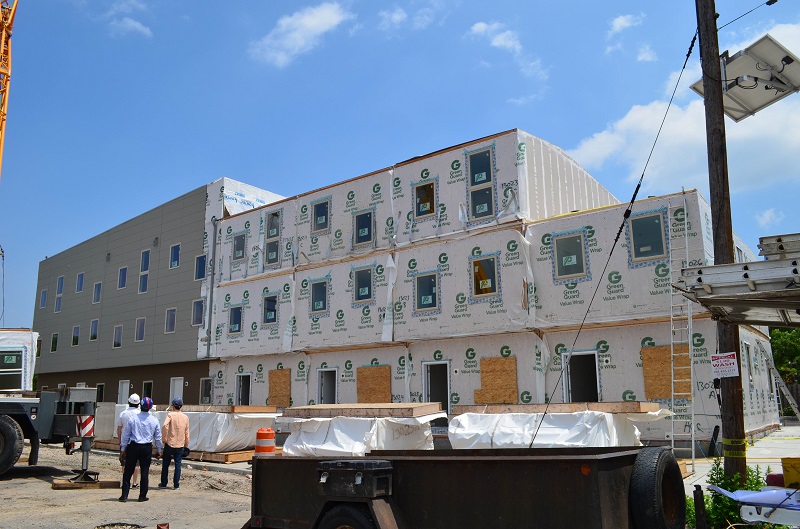
Mixed-Income Modular Townhomes in Jersey City

Jackson Green will increase high-quality home ownership opportunities in Jersey City’s Jackson Hill neighborhood. Image courtesy of GRO Architects and TRF Development Partners.
In July 2013, residents and city leaders in Jersey City, New Jersey held an open house and block party for eight new townhomes in the Jackson Hill neighborhood. Scheduled for completion by December 2013, the 22-unit Jackson Green development is one of the latest efforts of the Jersey City Redevelopment Agency (JCRA) to provide sustainable homeownership for low- and moderate-income households. The project, which employs modular construction methods and is built to achieve Leadership in Energy and Environmental Design (LEED) Silver certification, represents JCRA’s continued efforts to improve the quality of workforce housing across the city and support neighborhood revitalization.
Workforce Housing
In the mid-2000s, Jersey City realized that it was losing vital members of the community, according to JCRA executive director Robert P. Antonicello. Teachers, firefighters, and other moderate-income employees were moving out of the city to find better quality, more affordable housing. In response, JCRA created a workforce housing development program to provide sustainable, durable, and affordable housing for households earning between 90 and 120 percent of the area median income (AMI).
To meet these goals, the agency has sought innovative solutions that address rising construction costs and promote neighborhood investment. Applying these principles to the Jackson Green development, JCRA and its partners, Interfaith Community Organization, TRF Development Partners, and GRO Architects, are pairing modular construction with modern design to supply affordable, high-quality workforce housing in Jackson Hill.
Modern Modular Design

The modules were shipped to site where interior and exterior finishes were applied. Image courtesy of GRO Architects and TRF Development Partners.
Construction of the Jackson Green townhomes cost $126 per square foot, considerably less than the $200 per square foot for JCRA’s previous workforce housing developments. To keep costs low, the development team used modular construction techniques, with the units built in a factory before being shipped to the site as single-story modules. The modules were then set on foundations and stacked in three stories; exterior and interior finishes were then applied.
The homes were designed to be both affordable and appealing to potential homeowners who might otherwise leave the city. “We use design to broaden and expand markets,” says Sean Closkey, president of TRF Development Partners, in discussing the organization’s use of design as a tool for neighborhood revitalization. The three-story townhomes come in six floorplans ranging in size from 1,650 to 1,780 square feet. All units have an open floorplan on the main level and include three bedrooms, two and one-half baths, double-height ceilings, and private outdoor spaces. Some units feature bamboo flooring, solar-powered water heaters, and roof decks. With their sleek design that creates a modern identity in Jackson Hill, the townhomes appeal to workforce households of varying incomes and “create a different point on the demand curve,” according to Closkey.
Twelve of Jackson Green’s 22 townhomes will be available to households earning up to 80 percent of AMI. Prices for these units will range from $118,000 to $162,000. The remaining 10 units will be listed from $170,000 to $205,000 for households earning between 90 and 120 percent of AMI.
Built on JCRA-owned land, the project received approximately $1.6 million in Community Development Block Grant funds for infrastructure and site improvements and $1.3 million in HOME Investment Partnerships funds. The New Jersey Housing and Mortgage and Agency’s CHOICE program provided an additional $500,000. The program supports housing development in designated smart growth areas to build financially sustainable housing markets. Jackson Green meets program objectives by providing infill homeownership opportunities within a block of the Hudson-Bergen Light Rail line, which offers service throughout Hudson County and transfers to New York City.
The effort to provide new, attractive housing in Jackson Hill is paying off, with half of the units already sold. The development is the first in a series of workforce housing projects that TRF Development Partners and JCRA have planned in Jackson Hill. They see the Jackson Green project as an important step in positioning the neighborhood for future public- and private-sector investment. “There is a tendency in community development to look at projects as the output. We look at projects as the input, and measure market response as the output,” notes Closkey.
PD&R Leadership Message Archive
International & Philanthropic Spotlight Archive
Spotlight on PD&R Data Archive
Publications
Collecting, Analyzing, and Publicizing Data on Housing Turnover
Resilience Planning: What Communities Can Do to Keep Hazards from Turning into Disasters
Cityscape: Volume 26, Number 3
Case Studies
Case Study: Former School in Charleston, South Carolina, Transformed into Affordable Housing for Seniors
Case Study: Avalon Villas Combines Affordable Housing and Services for Families in a Gentrifying Phoenix Neighborhood

The contents of this article are the views of the author(s) and do not necessarily reflect the views or policies of the U.S. Department of Housing and Urban Development or the U.S. Government.
Note: Guidance documents, except when based on statutory or regulatory authority or law, do not have the force and effect of law and are not meant to bind the public in any way. Guidance documents are intended only to provide clarity to the public regarding existing requirements under the law or agency policies.



